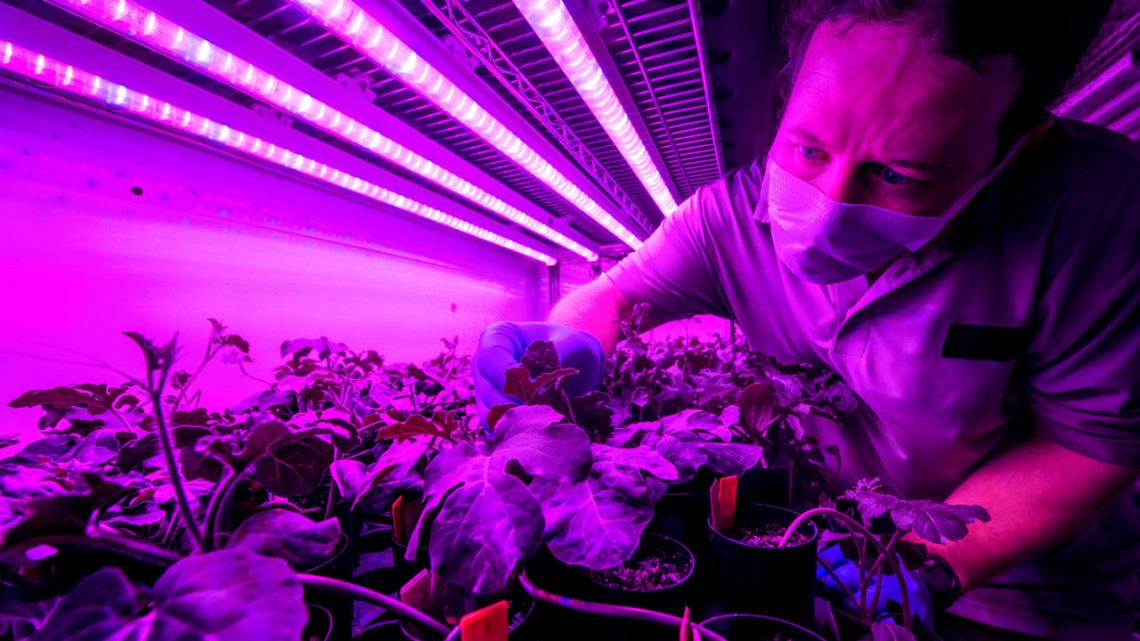
Breeding Insight supports U.S. scientists across the country. William Rutter, a USDA Agricultural Research Service scientist, is a member of the Breeding Insight working group for sweet potato.
Genomic selection eased for more plant, animal breeders
By Vanessa Greenlee
A Cornell program is adding seven new plant and animal species to its arsenal of supported specialty crops and animals for 2022 – an expansion that will help accelerate public and private plant and animal breeders’ efforts to introduce new varieties adapted to climate change, shifting consumer preferences and more.
The newly supported species – cranberry, cucumber, oat, lettuce, honey bee, pecan and strawberry – join the original lineup of six species supported by Breeding Insight, a Cornell program launched in 2018 and funded by the U.S. Department of Agriculture (USDA) to increase adoption of breeding analytics tools.
“Some of our most treasured and enjoyable food products come from specialty crops. Yet these crops are facing huge hurdles in a rapidly changing world,” said Moira Sheehan, director of Breeding Insight and adjunct associate professor of plant breeding and genetics in the School of Integrative Plant Science in the College of Agriculture and Life Sciences. “Breeding Insight is here to level the playing field for species that have lagged behind major commodity crop and animal breeding efforts.”
Plant and animal breeding can be a proverbial guessing game for making the “right” choice, as breeders must decide which individuals to keep and which to reject in an increasingly high-stakes effort to release newer and better varieties into our food supply, faster.
For generations breeders have relied on phenotypic selection, in which varieties are advanced based on human observations in fields and greenhouses. But often breeders only have short windows of time to collect, assimilate and act upon the information they gather. With phenotypic selection, they don’t get to see if they’ve made the most optimal selections until it’s too late to change course.
By combining traditional breeding approaches with genomic selection – the use of genetic markers to predict if certain traits are present – breeders can reduce uncertainty. But the prospect of making selections based primarily on genetic information can be daunting to breeders at first.
“There’s a lot of low-hanging fruit for applying genomic selection to all these really diverse specialty crops,” said Ed Buckler, research geneticist at the U.S. Department of Agriculture-Agricultural Research Service (USDA ARS) and adjunct professor of plant breeding and genetics with Cornell’s Institute of Biotechnology.
“Specialty plant and animal breeders can’t replicate over as many environments as major crop breeders can, so they really need to use the tools of genomic selection to integrate information over time and space,” Buckler said.
“Two main opportunities that consumers and society really demand are that we adapt specialty crops and animals to future environments and that we provide more flavor and nutrition. It’s common across all specialty species. And it’s something that we can do.”
Breeding Insight’s team of geneticists, biologists, plant breeders, and software developers support breeders on their technology adoption journey by making connections to existing resources and by delivering intuitive, high-powered software.
The program identifies phenotyping and genotyping platforms of interest, vets vendors to keep costs down, and works with breeders to implement enhanced data management systems. If needed functionalities are not available, Breeding Insight can create software to fill the gaps.
“We’re not looking to reinvent the wheel. We look at what’s available,” Sheehan said. “The goal is seamless back-end communication, so data is moving from one place to another without the need for manual transfer.”
USDA breeders not quite ready to adopt genomic selection can apply to participate in Breeding Insight OnRamp, a readiness initiative led by Amanda Hulse-Kemp, USDA ARS computational biologist and USDA assistant professor at North Carolina State University. The initiative helps breeders identify common traits and methods and curate historical data, so that when programs enter Breeding Insight, they are prepared to benefit from the services immediately.
“What I’m particularly excited about is we’re talking about a streamlined, organized set of tools,” said Kelley Richardson, USDA research geneticist and a participant in the Breeding Insight working group for lettuce. “Our group has been working with so many pieces of software in different places and with different information. So that idea that we could narrow that in – and particularly for the genotyping – it’s just super exciting.”
As Breeding Insight continues to grow, additional ARS breeding programs will be included, roughly on a two-year cycle.
A version of this story also appeared on the Breeding Insight website.
Vanessa Greenlee is communications and training lead for Breeding Insight.
Media Contact
Get Cornell news delivered right to your inbox.
Subscribe
